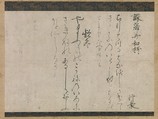Returned to lender The Met accepts temporary loans of art both for short-term exhibitions and for long-term display in its galleries.
Kasuga Poetry Sheet (Kasuga Kaishi) also referred to as Nara Poetry Sheet (Nara kaishi)
Calligrapher Unidentified artist
Not on view
Mounted as a hanging scroll suitable for display in an alcove, this is an excellent example of an early medieval wakagaishi, or poetry sheet inscribed with court poetry (waka). The themes of the poems are inscribed in Chinese, and the waka transcribed mostly in elegant kana according to conventional formats. In this case the poems, by Monk Gyōkai, are each arranged in two full columns (each containing twelve syllables) and a final column (with seven syllables). The poems read:
Rakka no waka o eizu
Chiri-hatsuru
hana o shikakete
sasagani no
ito koso haru no
tomarinarikeri
Composed on “Falling Blossoms”
As blossoms
start to scatter,
they will be trapped
by spiderwebs spun
in preparation for spring.
Kantō
Yamabuki no
kogane no iro
sakinureba
aruji o omou
hodo soshiraruru
On “Mountain Roses”
The mountain rose
has burst into bloom,
glistening bright gold,
as if to reveal its love
for the house’s master!
—Trans. John T. Carpenter
Due to rights restrictions, this image cannot be enlarged, viewed at full screen, or downloaded.
This artwork is meant to be viewed from right to left. Scroll left to view more.



